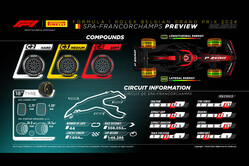 The last Grand Prix before the summer break takes place at Spa-Francorchamps, one of the most awe-inspiring race tracks in the world, that has witnessed some of the greatest moments in the history of the sport.
The last Grand Prix before the summer break takes place at Spa-Francorchamps, one of the most awe-inspiring race tracks in the world, that has witnessed some of the greatest moments in the history of the sport.
Seven spectacular kilometres that wend their way on roads that climb and drop through the forests of the Ardennes, making the location even more magical, but ready to catch out the drivers at every turn. Eau Rouge, Raidillon, La Source, Kemmel, Stavelot and Malmedy are just some of the names that have made the venue for the Belgian Grand Prix famous around the world.
There's been racing in the Ardennes for over a century with the first race, for motorcycles, taking place in 1921. The first Belgian Grand Prix was held the following year on a road circuit making use of three sides of a triangle which joined the towns of Spa-Francorchamps, Malmedy and Stavelot. This year, the track has had a makeover, with much of it having been resurfaced, which will be an important factor for the teams to take into account when preparing for the event.
Pirelli has already been able to assess the new asphalt, a month ago during the 24 Hours of Spa, the classic GTWC race for which the Italian company is the sole tyre supplier. During last June's race, the GT3 cars lapped three seconds quicker than the previous year, with the same compounds. Of course the performance level of the GT cars cannot be compared to that of a Formula 1 car, not even using the current, highly advanced simulation tools. But it is highly likely that the new surface will lead to a significant reduction in lap times and a considerable increase in the grip level on the resurfaced sections.
For this, the 14th round of the season, Pirelli has chosen the same trio of compounds as used for the last two years, namely C2 as P Zero White hard, the C3 as P Zero Yellow medium and the C4 as P Zero Red soft. In terms of stress on the tyres, it is one of the tracks with the highest average levels, even if it does not reach the peaks seen at Silverstone and Suzuka. The track features all corner types, linked by very fast sections, which makes it difficult for the teams to identify the ideal aerodynamic compromise. In fact, it is not unusual to see cars that are very strong in the fastest first and third sectors, struggling in the second slower one, or vice versa. Some combinations of corners, for example, Eau Rouge-Raidillon are very demanding and have unique characteristics, in this specific case a strong compression which puts a lot of stress on both the driver and the car. Usually, degradation at this track is mainly thermal, but the new surface could be a decisive factor in this area, given the extra grip afforded to the tyres.
Finally, how can one discuss a race weekend at Spa-Francorchamps without taking the weather into consideration? If there is a single venue on the motor racing calendar, not just F1, where variable weather can play a role, it is this one. Not only can conditions change from one day to the next, but also grip levels can be dramatically different at various points on the track at the same time. Furthermore, because it is such a long lap, the slightest little mistake in judging the right moment to switch from dry to wet tyres or vice versa can carry a severe penalty in the race and even more so in qualifying. Last year there was no rain during the race, but it had put in an appearance in the days leading up to it on what was a Sprint weekend. On Sunday afternoon, all the drivers ran slicks, the vast majority (13) favouring the Medium compound against seven going for the Soft. Only Norris used a set of Hard tyres for a dozen or so laps. Of those drivers who completed the race, most made two stops, the exceptions being Russell, Stroll and Gasly who split the 44 laps almost into equal parts: the Mercedes driver did a 22 lap first stint on the Medium before switching to Softs, while Stroll did 20 on the C3 followed by 24 with the C4, and the Alpine driver did his opening 23 lap on the Softs before switching to the Medium compound. The Englishman and the Canadian managed to finish in the points, in sixth and ninth places respectively.
This weekend's race is the 68th edition of the Belgian Grand Prix as a round of the Formula 1 World Championship. 56 of these have taken place at Spa-Francorchamps, ten at Zolder and two at Nivelles. The most successful driver in this event is Michael Schumacher with six wins, having made his debut at Spa in 1991, while the following year at the same track he took his maiden Formula 1 win, the first of 91. Next up at Spa are Ayrton Senna on five, and with three wins apiece are Lewis Hamilton, Kimi Raikkonen and Jim Clark. Hamilton has the most poles with six and most podium finishes (10). Of the constructors, Ferrari leads the way on 18 wins, followed by McLaren with 14 and Lotus on eight. The Scuderia also tops the list of pole positions (16) and podium finishes (50).
While the Belgian Grand Prix is the last race before the summer break, Pirelli's work continues as it is staying on for two more days of testing at the Spa-Francorchamps circuit. Supporting the programme aimed at development of constructions and compounds for 2025 will be Aston Martin and Alpine, each running one car over both days.






















sign in